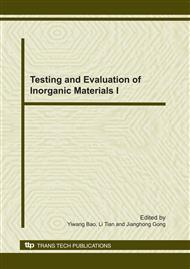p.526
p.530
p.533
p.537
p.541
p.545
p.549
p.554
p.558
Temperature Effect on Breakage Behavior of Cement Clinker by Compression
Abstract:
This paper describes the temperature effect on breakage behavior of cement clinker by single particle compression test. Portland cement clinker nodules, with mean diameter of 22 mm, were chosen as the test specimens. They were treated with heating to the temperatures of 300°C and 1000°C or cooling to -20°C and -88°C, respectively. The breakage behaviors were compared with the untreated nodules. The compression force-displacement profiles show that the treated nodules are easier to be broken because of the micro-cracks. Scanning electron microscope images illustrate that the clinker microstructures were changed after heating or cooling treatments. However, the main components are still the same according to the examination of X-ray diffraction. Comparing the heating with the cooling processes, it is more possible to use the waste heat of clinker sintering stage to reheat the clinker nodules, and these new reheating circuits may improve the energy efficiency of comminution.
Info:
Periodical:
Pages:
541-544
Citation:
Online since:
December 2010
Authors:
Keywords:
Price:
Сopyright:
© 2011 Trans Tech Publications Ltd. All Rights Reserved
Share:
Citation:


